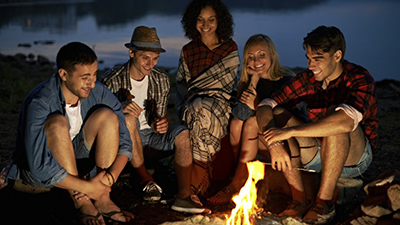Canada, Global Warming and Forest Fires
Posted on Friday, April 21, 2017, 03:16 PM, by Nicole Schurott, under
Activities, Did You Know

Forest fires are generally caused by lightning storms, human activity, or by an increase in temperature. With temperatures on the rise, this summer is expected to be warmer than usual.
Mike Flannigan, meteorologist and professor at the University of Alberta, predicts that the warmer weather will bring more fires.
On average, there are nearly 7,000 forest fires in a single year; the numbers vary dramatically depending on weather. However, we are expected to have a warmer summer and so a longer fire season. The numbers will be affected in a negative way.
While it is nearly impossible to put an end to the blazes, there are
steps to take to lower the risk of fires.
Pick the proper spot. If the campgrounds don’t allow campfires, don’t build it... it’s that simple. There is a reason they don’t allow them.
- If the conditions are too dry, DON’T build a fire!
- If you are going camping, check to see if the grounds have an existing pit or ring. These exist, because these are ideal spots to build fires. If there isn’t an existing one -- and pits are allowed -- make sure the site you choose is at least 15 feet from any trees, shrubs, tent walls, or other flammable objects. If there are none, clear a spot (15 feet in diameter). Your location should also be away from any logs, brush, decaying leaves, or other heavy fuels. Note: Your pit should be about .30 metres deep.
- If conditions are windy, take the direction of the wind into consideration. Just because it is windy, it doesn’t mean you can’t build a fire. You must be more careful, and choose a spot that is protected from any random gusts of wind that may occur.
- Surround the pit with rocks to create a barrier. Before you build the fire, make sure you have enough water for extinguishing, a bucket, and a shovel. Keep these near the pit at all times!
- To fuel your fire, never cut down an entire tree or branches -- regardless of whether they are dead or alive -- as you would aid in damaging the forest as well as destroying the homes of animals. Instead, search for small twigs, dry leaves, grass/needles (tinder), sticks smaller than 1” around (kindling), and larger pieces of wood (fuel). Make sure to keep the stacks of wood upwind, so they don’t catch fire accidentally.
- Loosely pile two or three handfuls of tinder in the center of the pit to start.
- Light the tinder, wait until the match is cold, then discard it into the fire.
- As the fire grows, add more tinder. Blow lightly at the base of the fire to help it grow.
- When the fire gets a little stronger, add kindling and fuel to help the fire grow larger. Note: Fire should remain small and under control.
- When extinguishing a campfire, make sure you are thorough; the fire can smolder for hours and continue to burn underground if conditions allow. When putting out a fire, be sure to use more than one bucket of water to make sure it is out completely. The goal is to pour water on the fire/embers (red and black) until all the hissing stops. If you do not have access to a lot of water, mix dirt and/or sand into the mix to bury the embers. Do this until all material is cool to-the-touch. A good rule of thumb is, "If it’s too hot to touch, then it’s too hot to leave."
- Scrape the remaining sticks and logs, removing any embers that may remain.